Organisation Leadership and Management Report and Analysis
VerifiedAdded on 2023/01/12
|14
|4981
|75
Report
AI Summary
This report delves into the critical concepts of leadership and management, highlighting their distinct yet complementary roles in organizational success. It begins by differentiating between leadership and management, exploring their respective functions, responsibilities, and the importance of effective leadership styles. The report then examines transformational and transactional leadership theories, analyzing their principles, applications, and influence on organizational dynamics. Furthermore, it discusses the significance of leadership development programs, emphasizing their role in enhancing employee engagement, fostering productive work environments, and driving overall organizational growth. The report includes an evaluation of a leadership development program, assessing its components and benefits. Through this analysis, the report provides valuable insights into the essential elements of effective leadership and management practices.
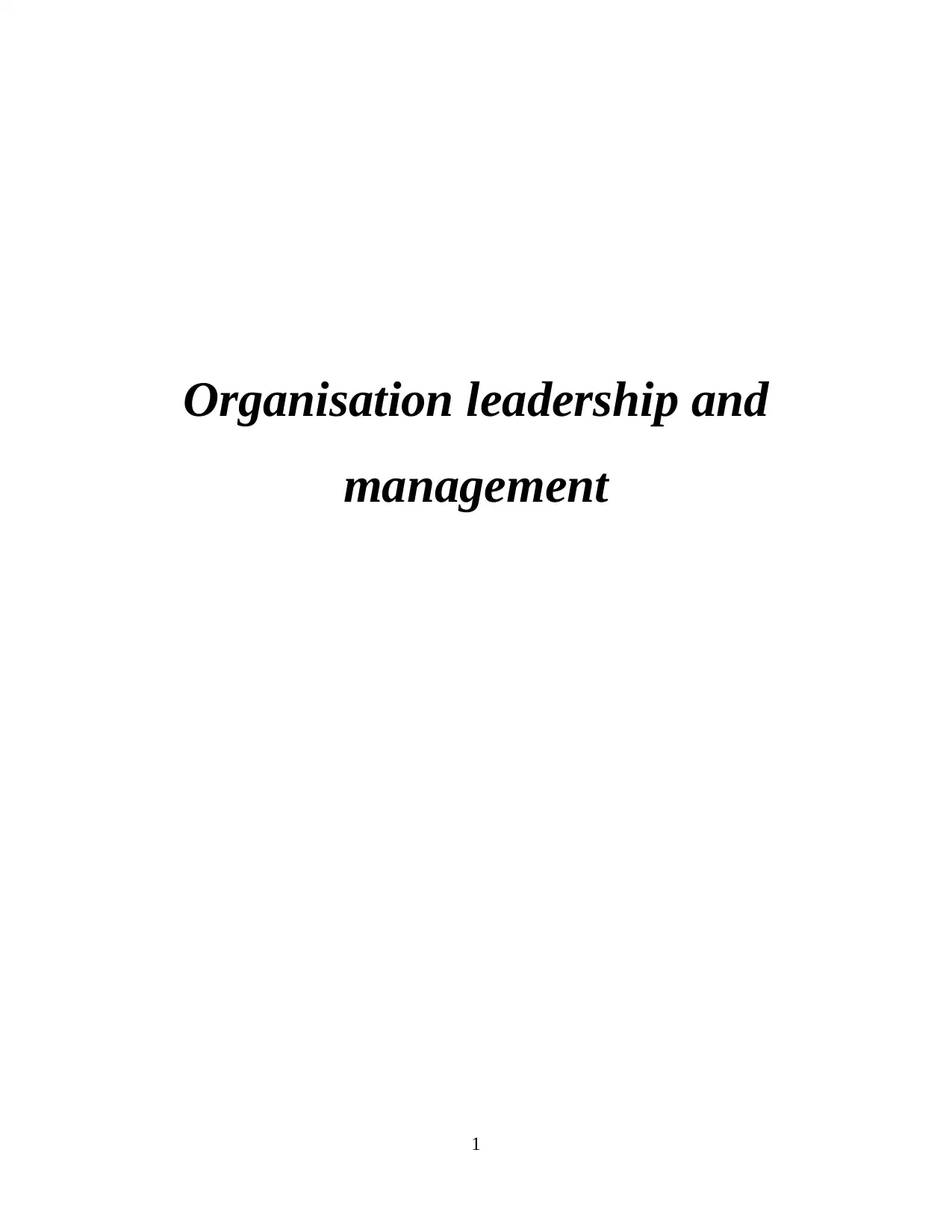
Organisation leadership and
management
1
management
1
Paraphrase This Document
Need a fresh take? Get an instant paraphrase of this document with our AI Paraphraser
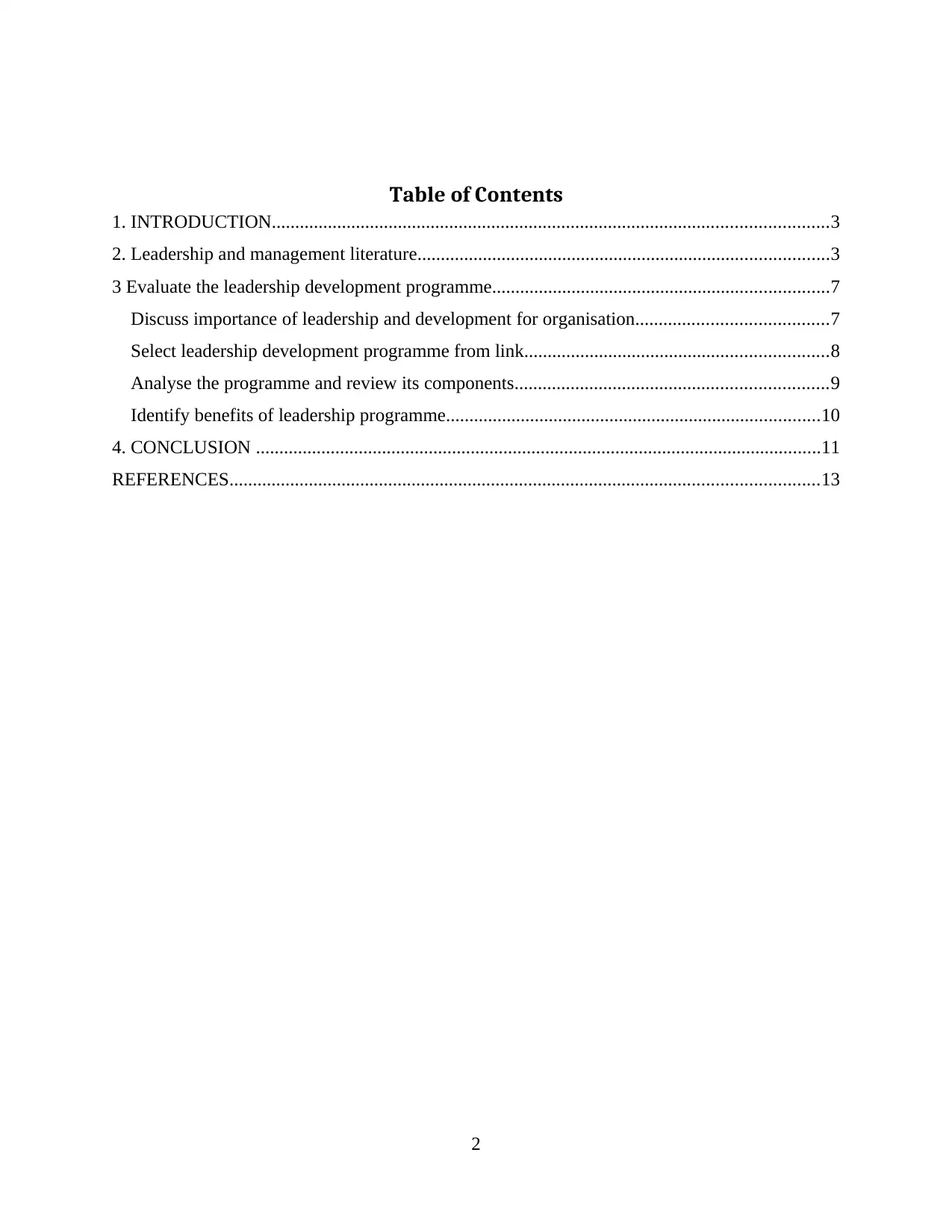
Table of Contents
1. INTRODUCTION.......................................................................................................................3
2. Leadership and management literature........................................................................................3
3 Evaluate the leadership development programme........................................................................7
Discuss importance of leadership and development for organisation.........................................7
Select leadership development programme from link.................................................................8
Analyse the programme and review its components...................................................................9
Identify benefits of leadership programme................................................................................10
4. CONCLUSION .........................................................................................................................11
REFERENCES..............................................................................................................................13
2
1. INTRODUCTION.......................................................................................................................3
2. Leadership and management literature........................................................................................3
3 Evaluate the leadership development programme........................................................................7
Discuss importance of leadership and development for organisation.........................................7
Select leadership development programme from link.................................................................8
Analyse the programme and review its components...................................................................9
Identify benefits of leadership programme................................................................................10
4. CONCLUSION .........................................................................................................................11
REFERENCES..............................................................................................................................13
2
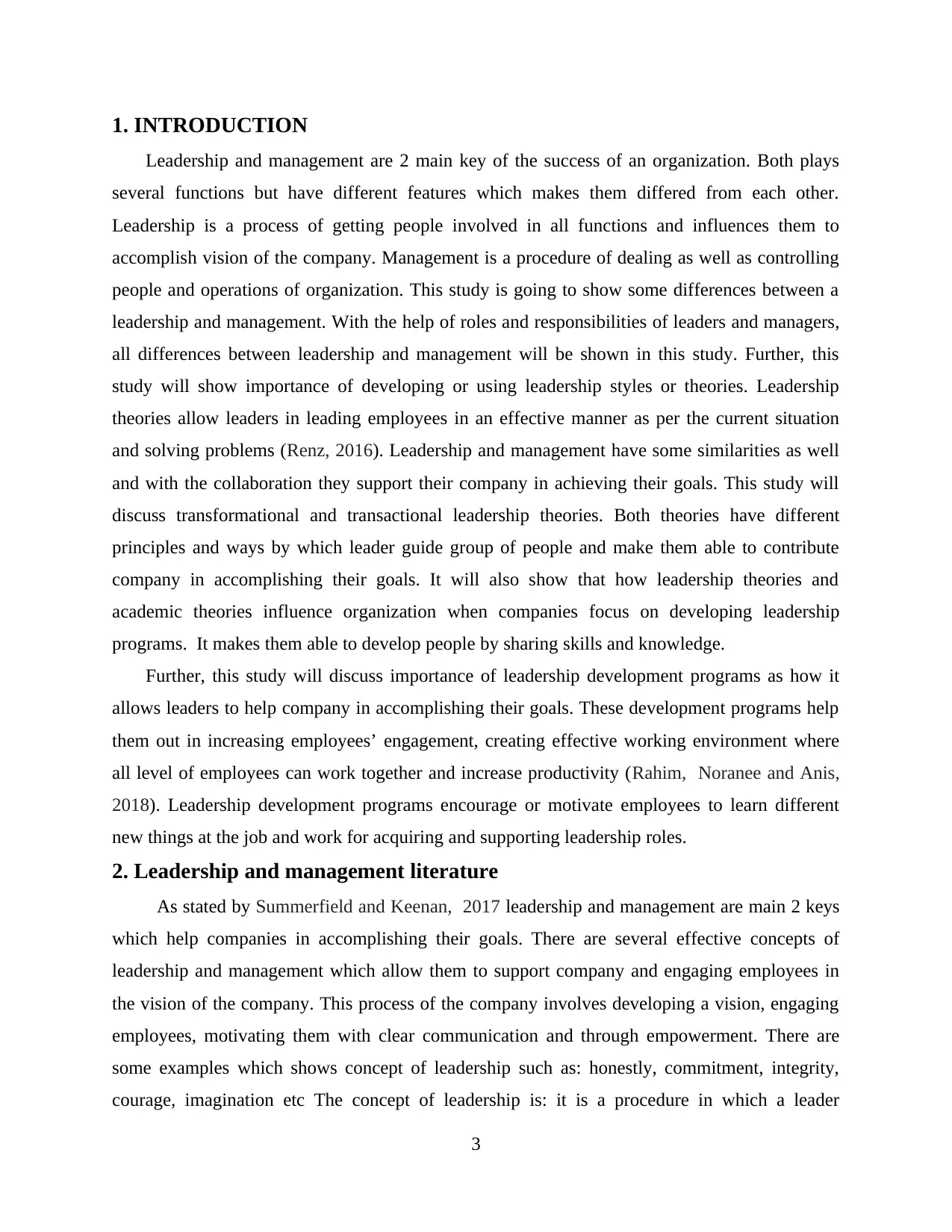
1. INTRODUCTION
Leadership and management are 2 main key of the success of an organization. Both plays
several functions but have different features which makes them differed from each other.
Leadership is a process of getting people involved in all functions and influences them to
accomplish vision of the company. Management is a procedure of dealing as well as controlling
people and operations of organization. This study is going to show some differences between a
leadership and management. With the help of roles and responsibilities of leaders and managers,
all differences between leadership and management will be shown in this study. Further, this
study will show importance of developing or using leadership styles or theories. Leadership
theories allow leaders in leading employees in an effective manner as per the current situation
and solving problems (Renz, 2016). Leadership and management have some similarities as well
and with the collaboration they support their company in achieving their goals. This study will
discuss transformational and transactional leadership theories. Both theories have different
principles and ways by which leader guide group of people and make them able to contribute
company in accomplishing their goals. It will also show that how leadership theories and
academic theories influence organization when companies focus on developing leadership
programs. It makes them able to develop people by sharing skills and knowledge.
Further, this study will discuss importance of leadership development programs as how it
allows leaders to help company in accomplishing their goals. These development programs help
them out in increasing employees’ engagement, creating effective working environment where
all level of employees can work together and increase productivity (Rahim, Noranee and Anis,
2018). Leadership development programs encourage or motivate employees to learn different
new things at the job and work for acquiring and supporting leadership roles.
2. Leadership and management literature
As stated by Summerfield and Keenan, 2017 leadership and management are main 2 keys
which help companies in accomplishing their goals. There are several effective concepts of
leadership and management which allow them to support company and engaging employees in
the vision of the company. This process of the company involves developing a vision, engaging
employees, motivating them with clear communication and through empowerment. There are
some examples which shows concept of leadership such as: honestly, commitment, integrity,
courage, imagination etc The concept of leadership is: it is a procedure in which a leader
3
Leadership and management are 2 main key of the success of an organization. Both plays
several functions but have different features which makes them differed from each other.
Leadership is a process of getting people involved in all functions and influences them to
accomplish vision of the company. Management is a procedure of dealing as well as controlling
people and operations of organization. This study is going to show some differences between a
leadership and management. With the help of roles and responsibilities of leaders and managers,
all differences between leadership and management will be shown in this study. Further, this
study will show importance of developing or using leadership styles or theories. Leadership
theories allow leaders in leading employees in an effective manner as per the current situation
and solving problems (Renz, 2016). Leadership and management have some similarities as well
and with the collaboration they support their company in achieving their goals. This study will
discuss transformational and transactional leadership theories. Both theories have different
principles and ways by which leader guide group of people and make them able to contribute
company in accomplishing their goals. It will also show that how leadership theories and
academic theories influence organization when companies focus on developing leadership
programs. It makes them able to develop people by sharing skills and knowledge.
Further, this study will discuss importance of leadership development programs as how it
allows leaders to help company in accomplishing their goals. These development programs help
them out in increasing employees’ engagement, creating effective working environment where
all level of employees can work together and increase productivity (Rahim, Noranee and Anis,
2018). Leadership development programs encourage or motivate employees to learn different
new things at the job and work for acquiring and supporting leadership roles.
2. Leadership and management literature
As stated by Summerfield and Keenan, 2017 leadership and management are main 2 keys
which help companies in accomplishing their goals. There are several effective concepts of
leadership and management which allow them to support company and engaging employees in
the vision of the company. This process of the company involves developing a vision, engaging
employees, motivating them with clear communication and through empowerment. There are
some examples which shows concept of leadership such as: honestly, commitment, integrity,
courage, imagination etc The concept of leadership is: it is a procedure in which a leader
3
⊘ This is a preview!⊘
Do you want full access?
Subscribe today to unlock all pages.

Trusted by 1+ million students worldwide
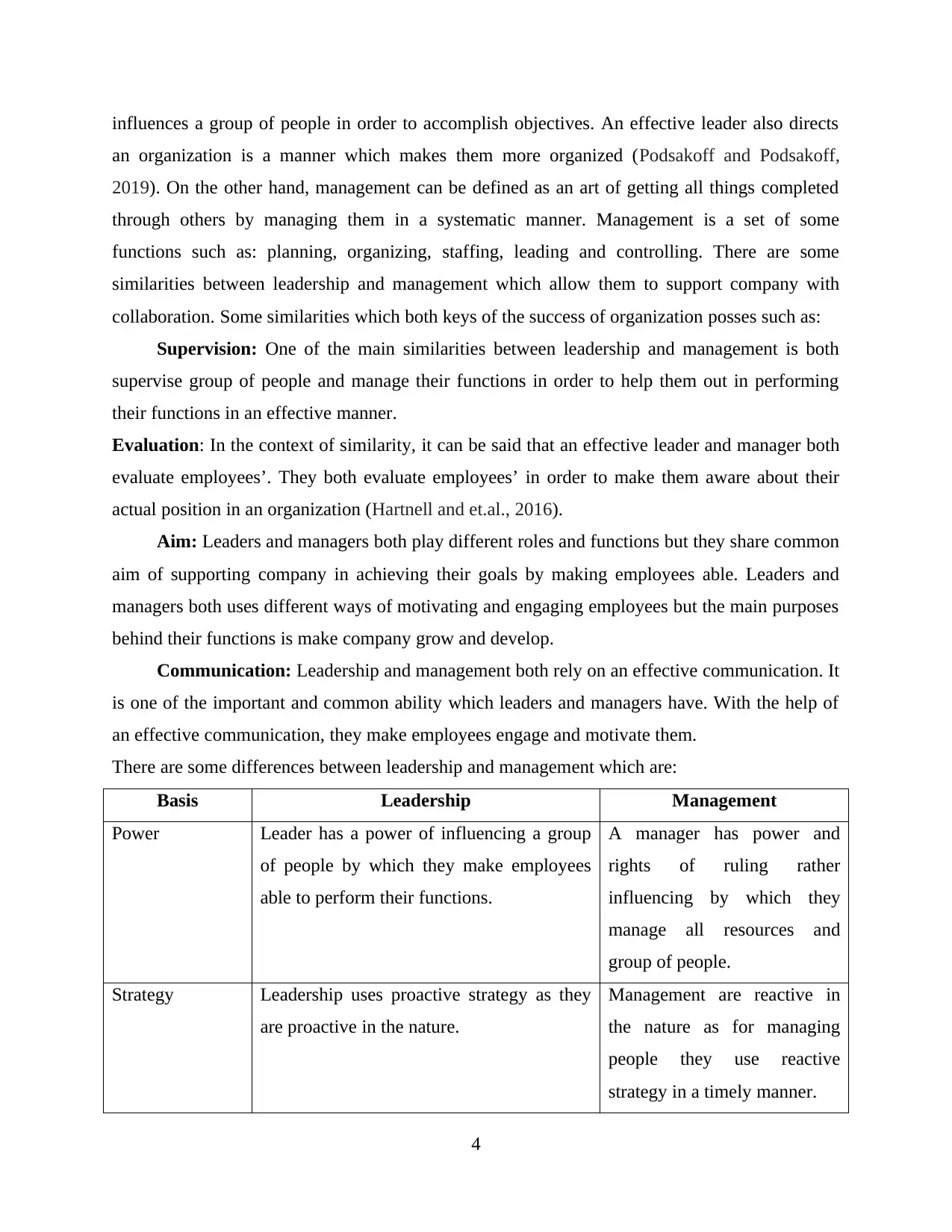
influences a group of people in order to accomplish objectives. An effective leader also directs
an organization is a manner which makes them more organized (Podsakoff and Podsakoff,
2019). On the other hand, management can be defined as an art of getting all things completed
through others by managing them in a systematic manner. Management is a set of some
functions such as: planning, organizing, staffing, leading and controlling. There are some
similarities between leadership and management which allow them to support company with
collaboration. Some similarities which both keys of the success of organization posses such as:
Supervision: One of the main similarities between leadership and management is both
supervise group of people and manage their functions in order to help them out in performing
their functions in an effective manner.
Evaluation: In the context of similarity, it can be said that an effective leader and manager both
evaluate employees’. They both evaluate employees’ in order to make them aware about their
actual position in an organization (Hartnell and et.al., 2016).
Aim: Leaders and managers both play different roles and functions but they share common
aim of supporting company in achieving their goals by making employees able. Leaders and
managers both uses different ways of motivating and engaging employees but the main purposes
behind their functions is make company grow and develop.
Communication: Leadership and management both rely on an effective communication. It
is one of the important and common ability which leaders and managers have. With the help of
an effective communication, they make employees engage and motivate them.
There are some differences between leadership and management which are:
Basis Leadership Management
Power Leader has a power of influencing a group
of people by which they make employees
able to perform their functions.
A manager has power and
rights of ruling rather
influencing by which they
manage all resources and
group of people.
Strategy Leadership uses proactive strategy as they
are proactive in the nature.
Management are reactive in
the nature as for managing
people they use reactive
strategy in a timely manner.
4
an organization is a manner which makes them more organized (Podsakoff and Podsakoff,
2019). On the other hand, management can be defined as an art of getting all things completed
through others by managing them in a systematic manner. Management is a set of some
functions such as: planning, organizing, staffing, leading and controlling. There are some
similarities between leadership and management which allow them to support company with
collaboration. Some similarities which both keys of the success of organization posses such as:
Supervision: One of the main similarities between leadership and management is both
supervise group of people and manage their functions in order to help them out in performing
their functions in an effective manner.
Evaluation: In the context of similarity, it can be said that an effective leader and manager both
evaluate employees’. They both evaluate employees’ in order to make them aware about their
actual position in an organization (Hartnell and et.al., 2016).
Aim: Leaders and managers both play different roles and functions but they share common
aim of supporting company in achieving their goals by making employees able. Leaders and
managers both uses different ways of motivating and engaging employees but the main purposes
behind their functions is make company grow and develop.
Communication: Leadership and management both rely on an effective communication. It
is one of the important and common ability which leaders and managers have. With the help of
an effective communication, they make employees engage and motivate them.
There are some differences between leadership and management which are:
Basis Leadership Management
Power Leader has a power of influencing a group
of people by which they make employees
able to perform their functions.
A manager has power and
rights of ruling rather
influencing by which they
manage all resources and
group of people.
Strategy Leadership uses proactive strategy as they
are proactive in the nature.
Management are reactive in
the nature as for managing
people they use reactive
strategy in a timely manner.
4
Paraphrase This Document
Need a fresh take? Get an instant paraphrase of this document with our AI Paraphraser
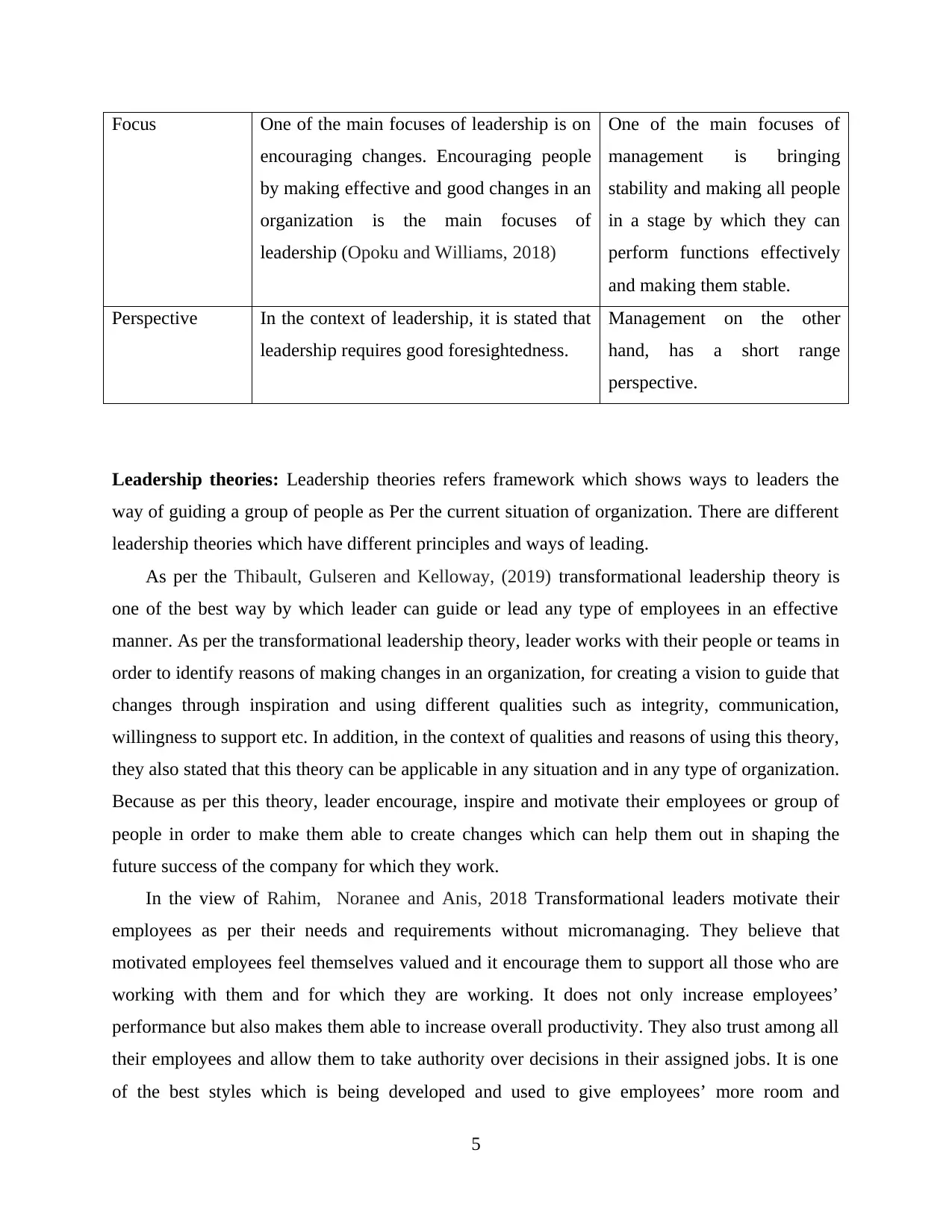
Focus One of the main focuses of leadership is on
encouraging changes. Encouraging people
by making effective and good changes in an
organization is the main focuses of
leadership (Opoku and Williams, 2018)
One of the main focuses of
management is bringing
stability and making all people
in a stage by which they can
perform functions effectively
and making them stable.
Perspective In the context of leadership, it is stated that
leadership requires good foresightedness.
Management on the other
hand, has a short range
perspective.
Leadership theories: Leadership theories refers framework which shows ways to leaders the
way of guiding a group of people as Per the current situation of organization. There are different
leadership theories which have different principles and ways of leading.
As per the Thibault, Gulseren and Kelloway, (2019) transformational leadership theory is
one of the best way by which leader can guide or lead any type of employees in an effective
manner. As per the transformational leadership theory, leader works with their people or teams in
order to identify reasons of making changes in an organization, for creating a vision to guide that
changes through inspiration and using different qualities such as integrity, communication,
willingness to support etc. In addition, in the context of qualities and reasons of using this theory,
they also stated that this theory can be applicable in any situation and in any type of organization.
Because as per this theory, leader encourage, inspire and motivate their employees or group of
people in order to make them able to create changes which can help them out in shaping the
future success of the company for which they work.
In the view of Rahim, Noranee and Anis, 2018 Transformational leaders motivate their
employees as per their needs and requirements without micromanaging. They believe that
motivated employees feel themselves valued and it encourage them to support all those who are
working with them and for which they are working. It does not only increase employees’
performance but also makes them able to increase overall productivity. They also trust among all
their employees and allow them to take authority over decisions in their assigned jobs. It is one
of the best styles which is being developed and used to give employees’ more room and
5
encouraging changes. Encouraging people
by making effective and good changes in an
organization is the main focuses of
leadership (Opoku and Williams, 2018)
One of the main focuses of
management is bringing
stability and making all people
in a stage by which they can
perform functions effectively
and making them stable.
Perspective In the context of leadership, it is stated that
leadership requires good foresightedness.
Management on the other
hand, has a short range
perspective.
Leadership theories: Leadership theories refers framework which shows ways to leaders the
way of guiding a group of people as Per the current situation of organization. There are different
leadership theories which have different principles and ways of leading.
As per the Thibault, Gulseren and Kelloway, (2019) transformational leadership theory is
one of the best way by which leader can guide or lead any type of employees in an effective
manner. As per the transformational leadership theory, leader works with their people or teams in
order to identify reasons of making changes in an organization, for creating a vision to guide that
changes through inspiration and using different qualities such as integrity, communication,
willingness to support etc. In addition, in the context of qualities and reasons of using this theory,
they also stated that this theory can be applicable in any situation and in any type of organization.
Because as per this theory, leader encourage, inspire and motivate their employees or group of
people in order to make them able to create changes which can help them out in shaping the
future success of the company for which they work.
In the view of Rahim, Noranee and Anis, 2018 Transformational leaders motivate their
employees as per their needs and requirements without micromanaging. They believe that
motivated employees feel themselves valued and it encourage them to support all those who are
working with them and for which they are working. It does not only increase employees’
performance but also makes them able to increase overall productivity. They also trust among all
their employees and allow them to take authority over decisions in their assigned jobs. It is one
of the best styles which is being developed and used to give employees’ more room and
5
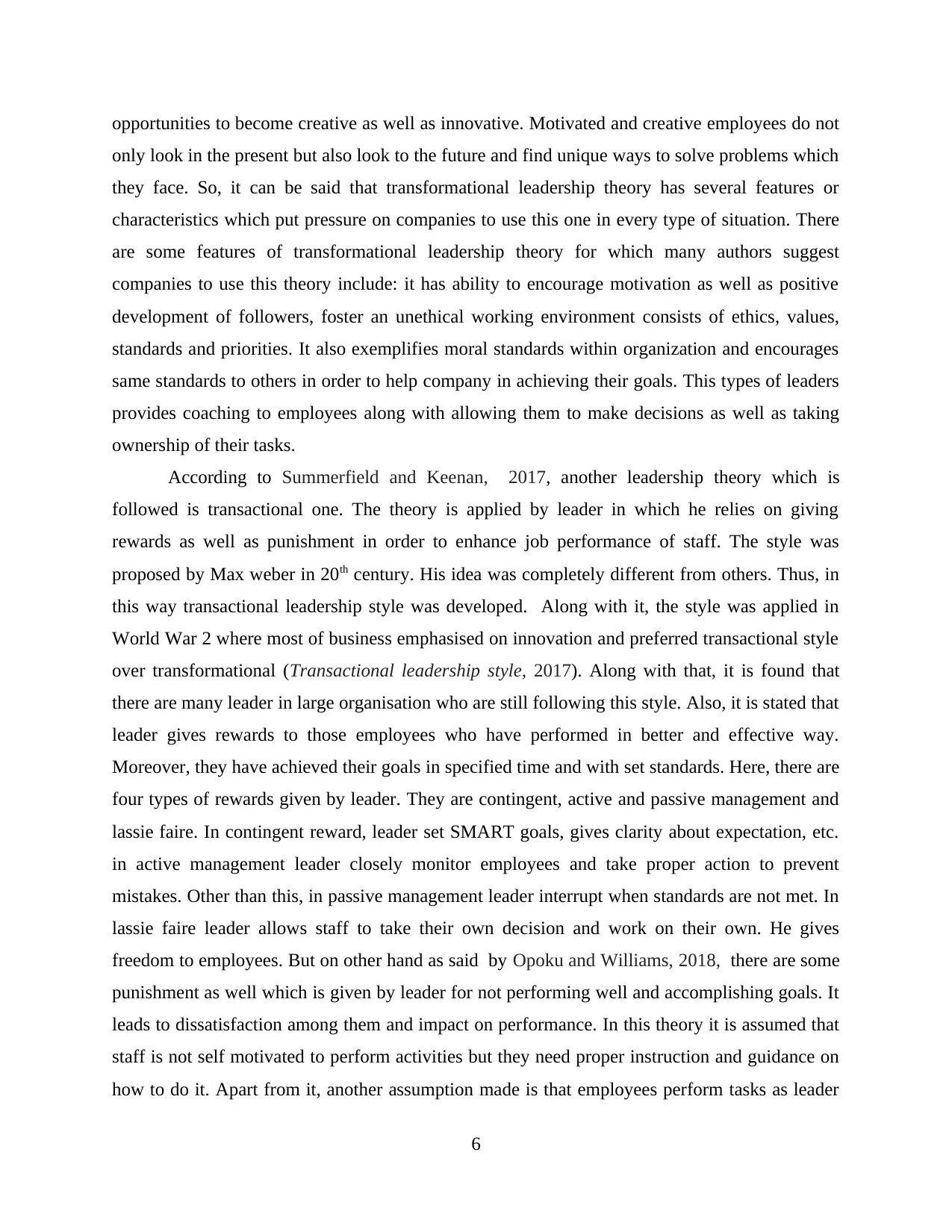
opportunities to become creative as well as innovative. Motivated and creative employees do not
only look in the present but also look to the future and find unique ways to solve problems which
they face. So, it can be said that transformational leadership theory has several features or
characteristics which put pressure on companies to use this one in every type of situation. There
are some features of transformational leadership theory for which many authors suggest
companies to use this theory include: it has ability to encourage motivation as well as positive
development of followers, foster an unethical working environment consists of ethics, values,
standards and priorities. It also exemplifies moral standards within organization and encourages
same standards to others in order to help company in achieving their goals. This types of leaders
provides coaching to employees along with allowing them to make decisions as well as taking
ownership of their tasks.
According to Summerfield and Keenan, 2017, another leadership theory which is
followed is transactional one. The theory is applied by leader in which he relies on giving
rewards as well as punishment in order to enhance job performance of staff. The style was
proposed by Max weber in 20th century. His idea was completely different from others. Thus, in
this way transactional leadership style was developed. Along with it, the style was applied in
World War 2 where most of business emphasised on innovation and preferred transactional style
over transformational (Transactional leadership style, 2017). Along with that, it is found that
there are many leader in large organisation who are still following this style. Also, it is stated that
leader gives rewards to those employees who have performed in better and effective way.
Moreover, they have achieved their goals in specified time and with set standards. Here, there are
four types of rewards given by leader. They are contingent, active and passive management and
lassie faire. In contingent reward, leader set SMART goals, gives clarity about expectation, etc.
in active management leader closely monitor employees and take proper action to prevent
mistakes. Other than this, in passive management leader interrupt when standards are not met. In
lassie faire leader allows staff to take their own decision and work on their own. He gives
freedom to employees. But on other hand as said by Opoku and Williams, 2018, there are some
punishment as well which is given by leader for not performing well and accomplishing goals. It
leads to dissatisfaction among them and impact on performance. In this theory it is assumed that
staff is not self motivated to perform activities but they need proper instruction and guidance on
how to do it. Apart from it, another assumption made is that employees perform tasks as leader
6
only look in the present but also look to the future and find unique ways to solve problems which
they face. So, it can be said that transformational leadership theory has several features or
characteristics which put pressure on companies to use this one in every type of situation. There
are some features of transformational leadership theory for which many authors suggest
companies to use this theory include: it has ability to encourage motivation as well as positive
development of followers, foster an unethical working environment consists of ethics, values,
standards and priorities. It also exemplifies moral standards within organization and encourages
same standards to others in order to help company in achieving their goals. This types of leaders
provides coaching to employees along with allowing them to make decisions as well as taking
ownership of their tasks.
According to Summerfield and Keenan, 2017, another leadership theory which is
followed is transactional one. The theory is applied by leader in which he relies on giving
rewards as well as punishment in order to enhance job performance of staff. The style was
proposed by Max weber in 20th century. His idea was completely different from others. Thus, in
this way transactional leadership style was developed. Along with it, the style was applied in
World War 2 where most of business emphasised on innovation and preferred transactional style
over transformational (Transactional leadership style, 2017). Along with that, it is found that
there are many leader in large organisation who are still following this style. Also, it is stated that
leader gives rewards to those employees who have performed in better and effective way.
Moreover, they have achieved their goals in specified time and with set standards. Here, there are
four types of rewards given by leader. They are contingent, active and passive management and
lassie faire. In contingent reward, leader set SMART goals, gives clarity about expectation, etc.
in active management leader closely monitor employees and take proper action to prevent
mistakes. Other than this, in passive management leader interrupt when standards are not met. In
lassie faire leader allows staff to take their own decision and work on their own. He gives
freedom to employees. But on other hand as said by Opoku and Williams, 2018, there are some
punishment as well which is given by leader for not performing well and accomplishing goals. It
leads to dissatisfaction among them and impact on performance. In this theory it is assumed that
staff is not self motivated to perform activities but they need proper instruction and guidance on
how to do it. Apart from it, another assumption made is that employees perform tasks as leader
6
⊘ This is a preview!⊘
Do you want full access?
Subscribe today to unlock all pages.

Trusted by 1+ million students worldwide
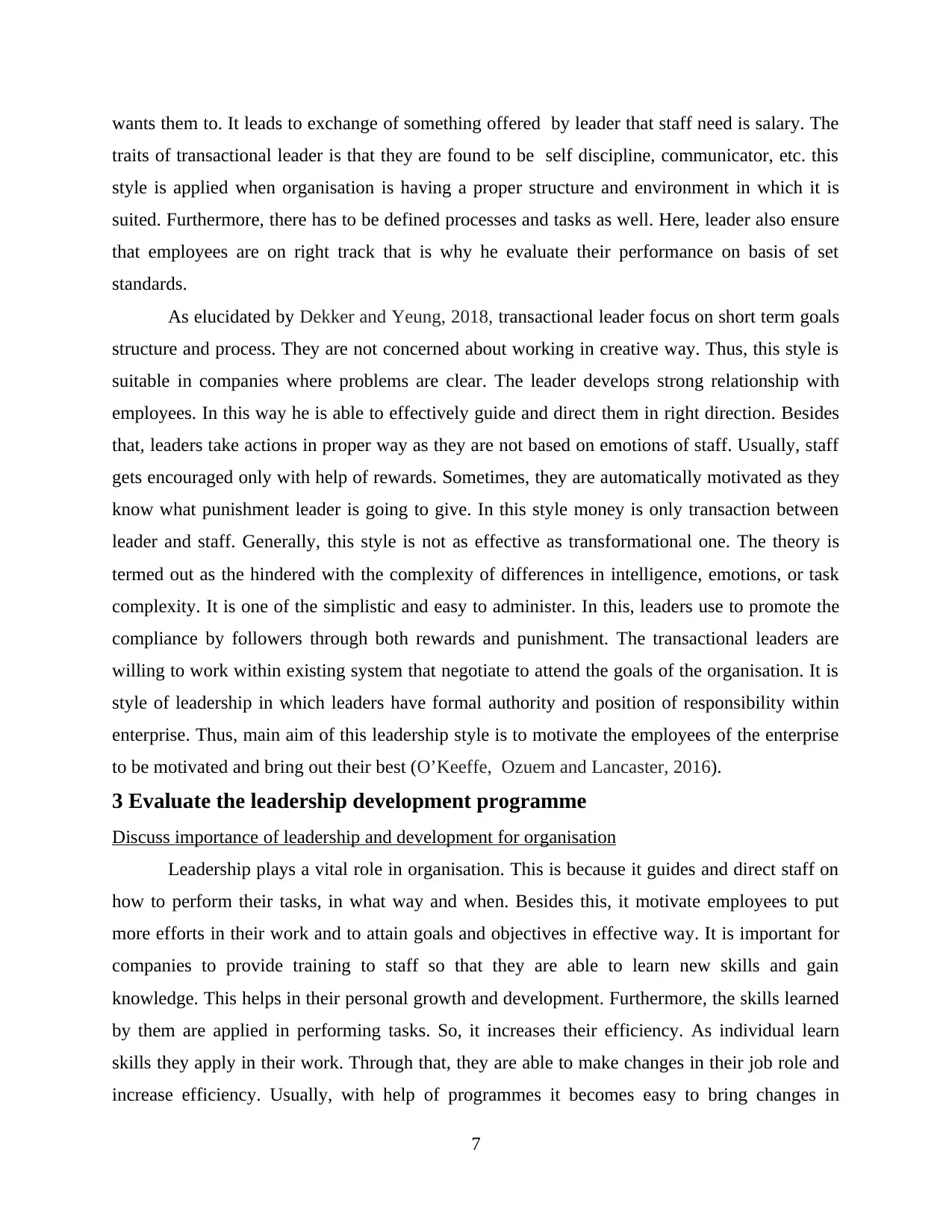
wants them to. It leads to exchange of something offered by leader that staff need is salary. The
traits of transactional leader is that they are found to be self discipline, communicator, etc. this
style is applied when organisation is having a proper structure and environment in which it is
suited. Furthermore, there has to be defined processes and tasks as well. Here, leader also ensure
that employees are on right track that is why he evaluate their performance on basis of set
standards.
As elucidated by Dekker and Yeung, 2018, transactional leader focus on short term goals
structure and process. They are not concerned about working in creative way. Thus, this style is
suitable in companies where problems are clear. The leader develops strong relationship with
employees. In this way he is able to effectively guide and direct them in right direction. Besides
that, leaders take actions in proper way as they are not based on emotions of staff. Usually, staff
gets encouraged only with help of rewards. Sometimes, they are automatically motivated as they
know what punishment leader is going to give. In this style money is only transaction between
leader and staff. Generally, this style is not as effective as transformational one. The theory is
termed out as the hindered with the complexity of differences in intelligence, emotions, or task
complexity. It is one of the simplistic and easy to administer. In this, leaders use to promote the
compliance by followers through both rewards and punishment. The transactional leaders are
willing to work within existing system that negotiate to attend the goals of the organisation. It is
style of leadership in which leaders have formal authority and position of responsibility within
enterprise. Thus, main aim of this leadership style is to motivate the employees of the enterprise
to be motivated and bring out their best (O’Keeffe, Ozuem and Lancaster, 2016).
3 Evaluate the leadership development programme
Discuss importance of leadership and development for organisation
Leadership plays a vital role in organisation. This is because it guides and direct staff on
how to perform their tasks, in what way and when. Besides this, it motivate employees to put
more efforts in their work and to attain goals and objectives in effective way. It is important for
companies to provide training to staff so that they are able to learn new skills and gain
knowledge. This helps in their personal growth and development. Furthermore, the skills learned
by them are applied in performing tasks. So, it increases their efficiency. As individual learn
skills they apply in their work. Through that, they are able to make changes in their job role and
increase efficiency. Usually, with help of programmes it becomes easy to bring changes in
7
traits of transactional leader is that they are found to be self discipline, communicator, etc. this
style is applied when organisation is having a proper structure and environment in which it is
suited. Furthermore, there has to be defined processes and tasks as well. Here, leader also ensure
that employees are on right track that is why he evaluate their performance on basis of set
standards.
As elucidated by Dekker and Yeung, 2018, transactional leader focus on short term goals
structure and process. They are not concerned about working in creative way. Thus, this style is
suitable in companies where problems are clear. The leader develops strong relationship with
employees. In this way he is able to effectively guide and direct them in right direction. Besides
that, leaders take actions in proper way as they are not based on emotions of staff. Usually, staff
gets encouraged only with help of rewards. Sometimes, they are automatically motivated as they
know what punishment leader is going to give. In this style money is only transaction between
leader and staff. Generally, this style is not as effective as transformational one. The theory is
termed out as the hindered with the complexity of differences in intelligence, emotions, or task
complexity. It is one of the simplistic and easy to administer. In this, leaders use to promote the
compliance by followers through both rewards and punishment. The transactional leaders are
willing to work within existing system that negotiate to attend the goals of the organisation. It is
style of leadership in which leaders have formal authority and position of responsibility within
enterprise. Thus, main aim of this leadership style is to motivate the employees of the enterprise
to be motivated and bring out their best (O’Keeffe, Ozuem and Lancaster, 2016).
3 Evaluate the leadership development programme
Discuss importance of leadership and development for organisation
Leadership plays a vital role in organisation. This is because it guides and direct staff on
how to perform their tasks, in what way and when. Besides this, it motivate employees to put
more efforts in their work and to attain goals and objectives in effective way. It is important for
companies to provide training to staff so that they are able to learn new skills and gain
knowledge. This helps in their personal growth and development. Furthermore, the skills learned
by them are applied in performing tasks. So, it increases their efficiency. As individual learn
skills they apply in their work. Through that, they are able to make changes in their job role and
increase efficiency. Usually, with help of programmes it becomes easy to bring changes in
7
Paraphrase This Document
Need a fresh take? Get an instant paraphrase of this document with our AI Paraphraser
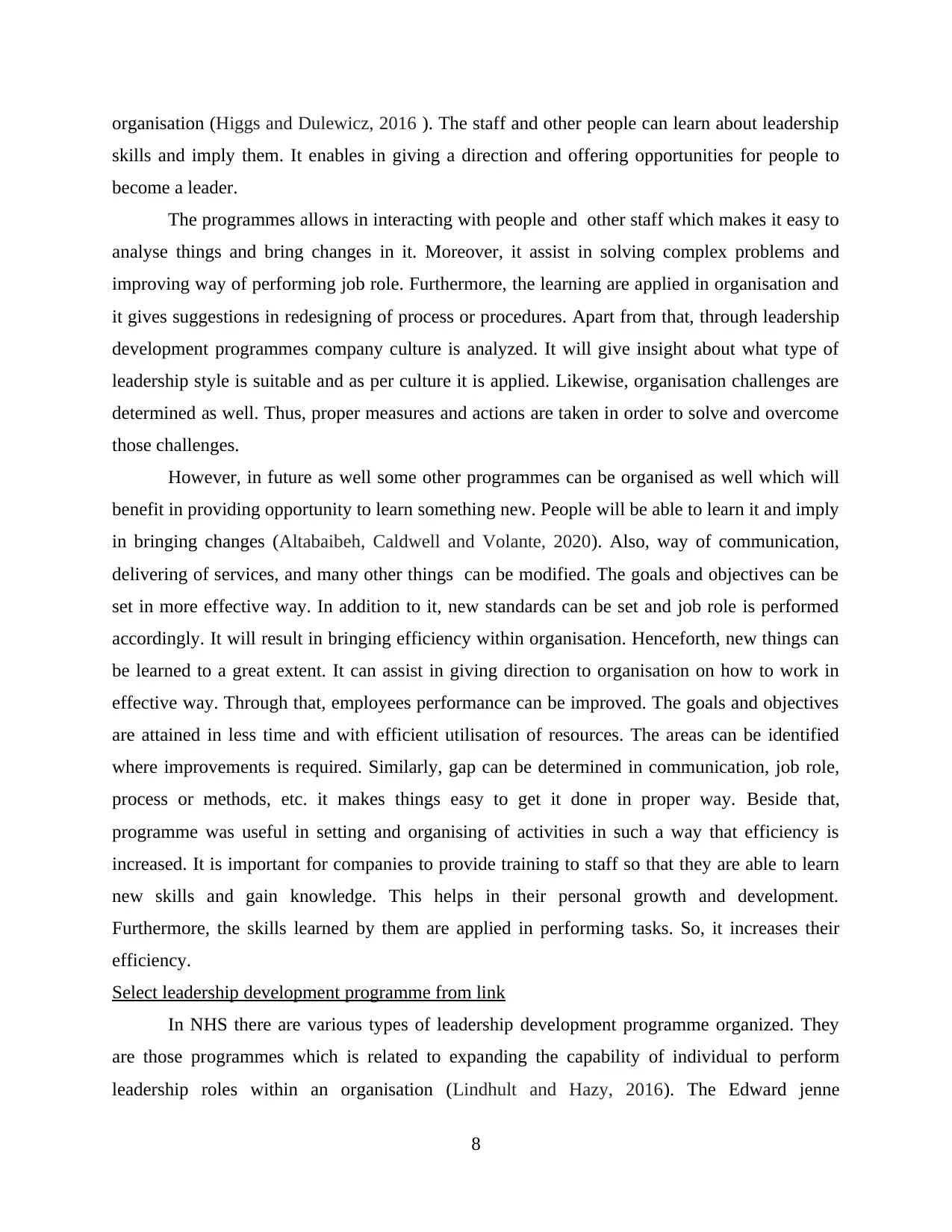
organisation (Higgs and Dulewicz, 2016 ). The staff and other people can learn about leadership
skills and imply them. It enables in giving a direction and offering opportunities for people to
become a leader.
The programmes allows in interacting with people and other staff which makes it easy to
analyse things and bring changes in it. Moreover, it assist in solving complex problems and
improving way of performing job role. Furthermore, the learning are applied in organisation and
it gives suggestions in redesigning of process or procedures. Apart from that, through leadership
development programmes company culture is analyzed. It will give insight about what type of
leadership style is suitable and as per culture it is applied. Likewise, organisation challenges are
determined as well. Thus, proper measures and actions are taken in order to solve and overcome
those challenges.
However, in future as well some other programmes can be organised as well which will
benefit in providing opportunity to learn something new. People will be able to learn it and imply
in bringing changes (Altabaibeh, Caldwell and Volante, 2020). Also, way of communication,
delivering of services, and many other things can be modified. The goals and objectives can be
set in more effective way. In addition to it, new standards can be set and job role is performed
accordingly. It will result in bringing efficiency within organisation. Henceforth, new things can
be learned to a great extent. It can assist in giving direction to organisation on how to work in
effective way. Through that, employees performance can be improved. The goals and objectives
are attained in less time and with efficient utilisation of resources. The areas can be identified
where improvements is required. Similarly, gap can be determined in communication, job role,
process or methods, etc. it makes things easy to get it done in proper way. Beside that,
programme was useful in setting and organising of activities in such a way that efficiency is
increased. It is important for companies to provide training to staff so that they are able to learn
new skills and gain knowledge. This helps in their personal growth and development.
Furthermore, the skills learned by them are applied in performing tasks. So, it increases their
efficiency.
Select leadership development programme from link
In NHS there are various types of leadership development programme organized. They
are those programmes which is related to expanding the capability of individual to perform
leadership roles within an organisation (Lindhult and Hazy, 2016). The Edward jenne
8
skills and imply them. It enables in giving a direction and offering opportunities for people to
become a leader.
The programmes allows in interacting with people and other staff which makes it easy to
analyse things and bring changes in it. Moreover, it assist in solving complex problems and
improving way of performing job role. Furthermore, the learning are applied in organisation and
it gives suggestions in redesigning of process or procedures. Apart from that, through leadership
development programmes company culture is analyzed. It will give insight about what type of
leadership style is suitable and as per culture it is applied. Likewise, organisation challenges are
determined as well. Thus, proper measures and actions are taken in order to solve and overcome
those challenges.
However, in future as well some other programmes can be organised as well which will
benefit in providing opportunity to learn something new. People will be able to learn it and imply
in bringing changes (Altabaibeh, Caldwell and Volante, 2020). Also, way of communication,
delivering of services, and many other things can be modified. The goals and objectives can be
set in more effective way. In addition to it, new standards can be set and job role is performed
accordingly. It will result in bringing efficiency within organisation. Henceforth, new things can
be learned to a great extent. It can assist in giving direction to organisation on how to work in
effective way. Through that, employees performance can be improved. The goals and objectives
are attained in less time and with efficient utilisation of resources. The areas can be identified
where improvements is required. Similarly, gap can be determined in communication, job role,
process or methods, etc. it makes things easy to get it done in proper way. Beside that,
programme was useful in setting and organising of activities in such a way that efficiency is
increased. It is important for companies to provide training to staff so that they are able to learn
new skills and gain knowledge. This helps in their personal growth and development.
Furthermore, the skills learned by them are applied in performing tasks. So, it increases their
efficiency.
Select leadership development programme from link
In NHS there are various types of leadership development programme organized. They
are those programmes which is related to expanding the capability of individual to perform
leadership roles within an organisation (Lindhult and Hazy, 2016). The Edward jenne
8
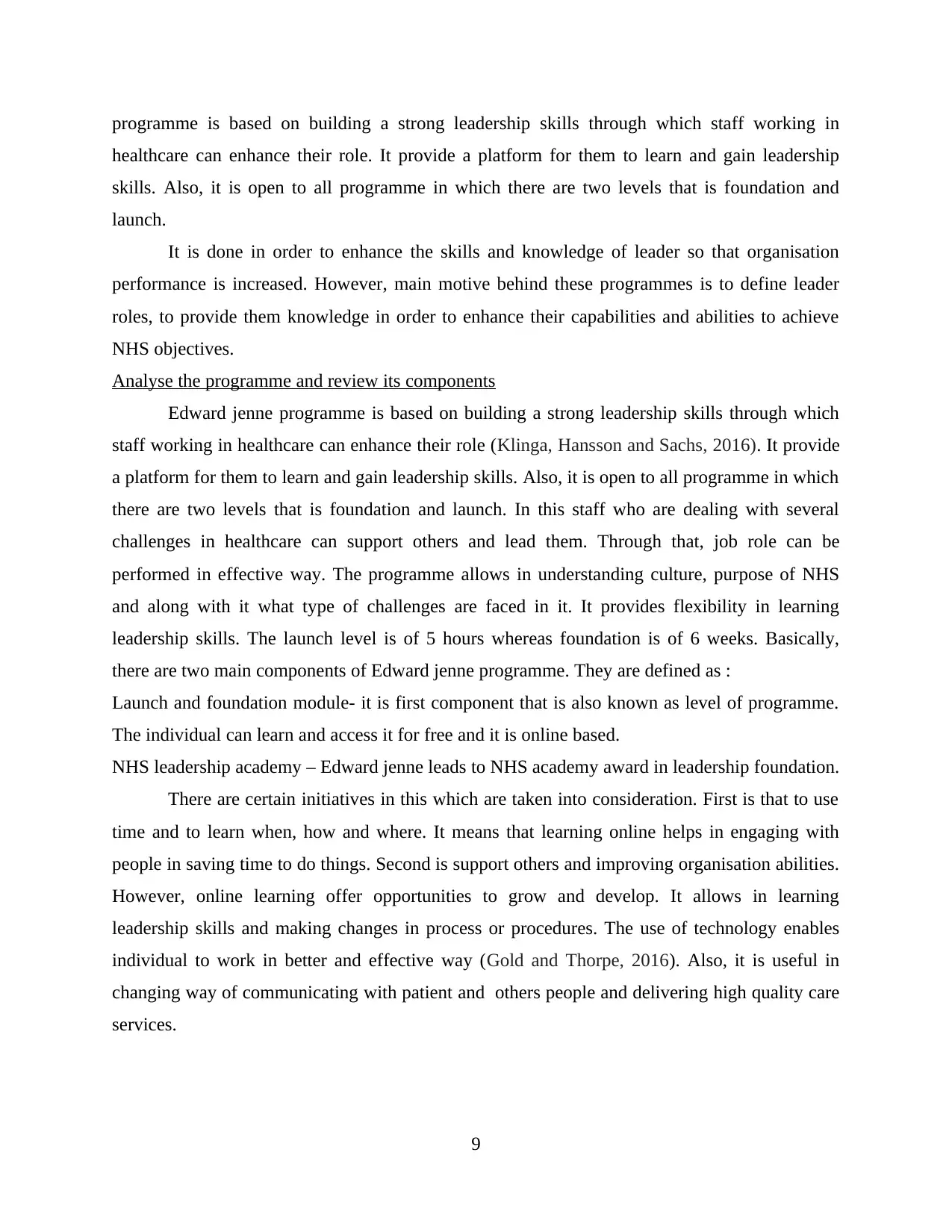
programme is based on building a strong leadership skills through which staff working in
healthcare can enhance their role. It provide a platform for them to learn and gain leadership
skills. Also, it is open to all programme in which there are two levels that is foundation and
launch.
It is done in order to enhance the skills and knowledge of leader so that organisation
performance is increased. However, main motive behind these programmes is to define leader
roles, to provide them knowledge in order to enhance their capabilities and abilities to achieve
NHS objectives.
Analyse the programme and review its components
Edward jenne programme is based on building a strong leadership skills through which
staff working in healthcare can enhance their role (Klinga, Hansson and Sachs, 2016). It provide
a platform for them to learn and gain leadership skills. Also, it is open to all programme in which
there are two levels that is foundation and launch. In this staff who are dealing with several
challenges in healthcare can support others and lead them. Through that, job role can be
performed in effective way. The programme allows in understanding culture, purpose of NHS
and along with it what type of challenges are faced in it. It provides flexibility in learning
leadership skills. The launch level is of 5 hours whereas foundation is of 6 weeks. Basically,
there are two main components of Edward jenne programme. They are defined as :
Launch and foundation module- it is first component that is also known as level of programme.
The individual can learn and access it for free and it is online based.
NHS leadership academy – Edward jenne leads to NHS academy award in leadership foundation.
There are certain initiatives in this which are taken into consideration. First is that to use
time and to learn when, how and where. It means that learning online helps in engaging with
people in saving time to do things. Second is support others and improving organisation abilities.
However, online learning offer opportunities to grow and develop. It allows in learning
leadership skills and making changes in process or procedures. The use of technology enables
individual to work in better and effective way (Gold and Thorpe, 2016). Also, it is useful in
changing way of communicating with patient and others people and delivering high quality care
services.
9
healthcare can enhance their role. It provide a platform for them to learn and gain leadership
skills. Also, it is open to all programme in which there are two levels that is foundation and
launch.
It is done in order to enhance the skills and knowledge of leader so that organisation
performance is increased. However, main motive behind these programmes is to define leader
roles, to provide them knowledge in order to enhance their capabilities and abilities to achieve
NHS objectives.
Analyse the programme and review its components
Edward jenne programme is based on building a strong leadership skills through which
staff working in healthcare can enhance their role (Klinga, Hansson and Sachs, 2016). It provide
a platform for them to learn and gain leadership skills. Also, it is open to all programme in which
there are two levels that is foundation and launch. In this staff who are dealing with several
challenges in healthcare can support others and lead them. Through that, job role can be
performed in effective way. The programme allows in understanding culture, purpose of NHS
and along with it what type of challenges are faced in it. It provides flexibility in learning
leadership skills. The launch level is of 5 hours whereas foundation is of 6 weeks. Basically,
there are two main components of Edward jenne programme. They are defined as :
Launch and foundation module- it is first component that is also known as level of programme.
The individual can learn and access it for free and it is online based.
NHS leadership academy – Edward jenne leads to NHS academy award in leadership foundation.
There are certain initiatives in this which are taken into consideration. First is that to use
time and to learn when, how and where. It means that learning online helps in engaging with
people in saving time to do things. Second is support others and improving organisation abilities.
However, online learning offer opportunities to grow and develop. It allows in learning
leadership skills and making changes in process or procedures. The use of technology enables
individual to work in better and effective way (Gold and Thorpe, 2016). Also, it is useful in
changing way of communicating with patient and others people and delivering high quality care
services.
9
⊘ This is a preview!⊘
Do you want full access?
Subscribe today to unlock all pages.

Trusted by 1+ million students worldwide
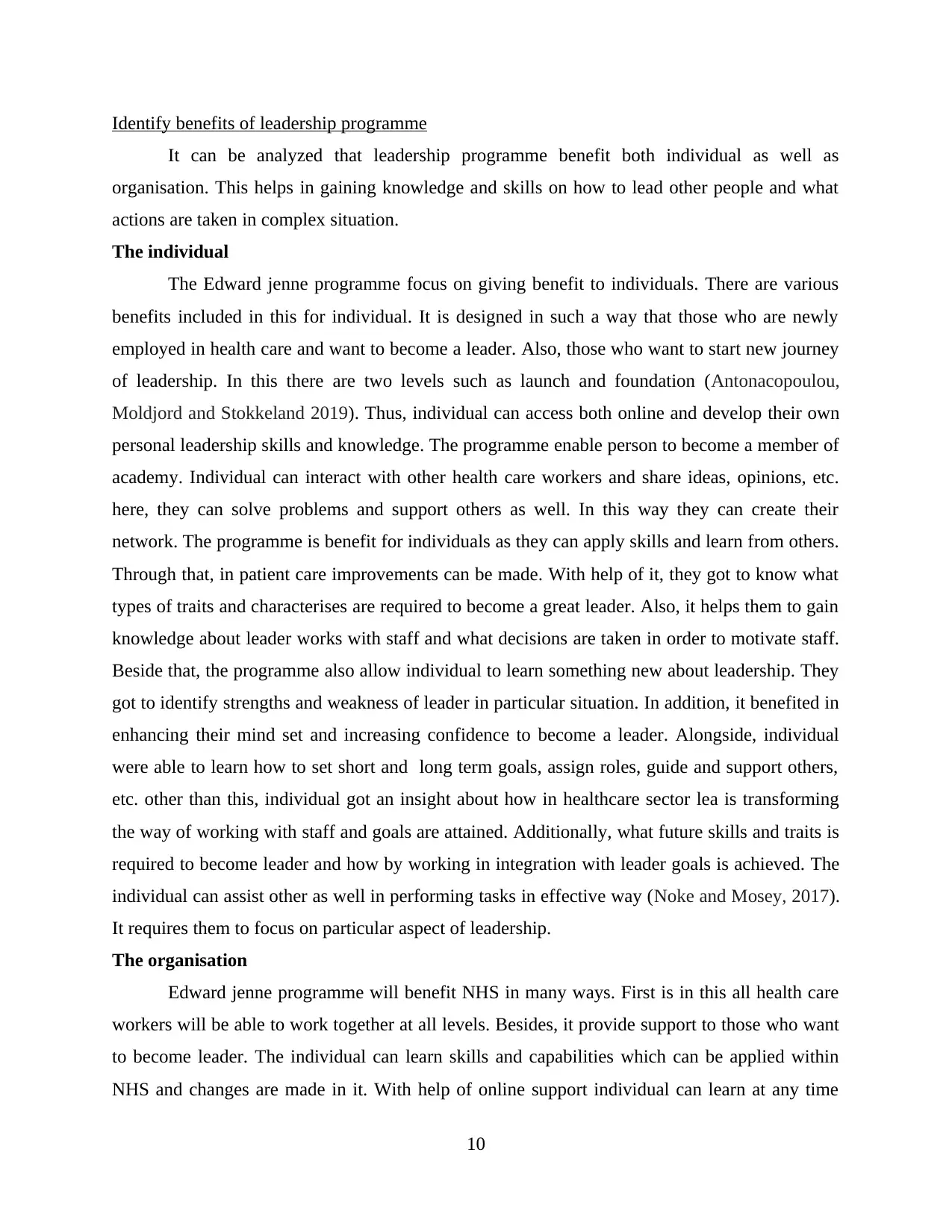
Identify benefits of leadership programme
It can be analyzed that leadership programme benefit both individual as well as
organisation. This helps in gaining knowledge and skills on how to lead other people and what
actions are taken in complex situation.
The individual
The Edward jenne programme focus on giving benefit to individuals. There are various
benefits included in this for individual. It is designed in such a way that those who are newly
employed in health care and want to become a leader. Also, those who want to start new journey
of leadership. In this there are two levels such as launch and foundation (Antonacopoulou,
Moldjord and Stokkeland 2019). Thus, individual can access both online and develop their own
personal leadership skills and knowledge. The programme enable person to become a member of
academy. Individual can interact with other health care workers and share ideas, opinions, etc.
here, they can solve problems and support others as well. In this way they can create their
network. The programme is benefit for individuals as they can apply skills and learn from others.
Through that, in patient care improvements can be made. With help of it, they got to know what
types of traits and characterises are required to become a great leader. Also, it helps them to gain
knowledge about leader works with staff and what decisions are taken in order to motivate staff.
Beside that, the programme also allow individual to learn something new about leadership. They
got to identify strengths and weakness of leader in particular situation. In addition, it benefited in
enhancing their mind set and increasing confidence to become a leader. Alongside, individual
were able to learn how to set short and long term goals, assign roles, guide and support others,
etc. other than this, individual got an insight about how in healthcare sector lea is transforming
the way of working with staff and goals are attained. Additionally, what future skills and traits is
required to become leader and how by working in integration with leader goals is achieved. The
individual can assist other as well in performing tasks in effective way (Noke and Mosey, 2017).
It requires them to focus on particular aspect of leadership.
The organisation
Edward jenne programme will benefit NHS in many ways. First is in this all health care
workers will be able to work together at all levels. Besides, it provide support to those who want
to become leader. The individual can learn skills and capabilities which can be applied within
NHS and changes are made in it. With help of online support individual can learn at any time
10
It can be analyzed that leadership programme benefit both individual as well as
organisation. This helps in gaining knowledge and skills on how to lead other people and what
actions are taken in complex situation.
The individual
The Edward jenne programme focus on giving benefit to individuals. There are various
benefits included in this for individual. It is designed in such a way that those who are newly
employed in health care and want to become a leader. Also, those who want to start new journey
of leadership. In this there are two levels such as launch and foundation (Antonacopoulou,
Moldjord and Stokkeland 2019). Thus, individual can access both online and develop their own
personal leadership skills and knowledge. The programme enable person to become a member of
academy. Individual can interact with other health care workers and share ideas, opinions, etc.
here, they can solve problems and support others as well. In this way they can create their
network. The programme is benefit for individuals as they can apply skills and learn from others.
Through that, in patient care improvements can be made. With help of it, they got to know what
types of traits and characterises are required to become a great leader. Also, it helps them to gain
knowledge about leader works with staff and what decisions are taken in order to motivate staff.
Beside that, the programme also allow individual to learn something new about leadership. They
got to identify strengths and weakness of leader in particular situation. In addition, it benefited in
enhancing their mind set and increasing confidence to become a leader. Alongside, individual
were able to learn how to set short and long term goals, assign roles, guide and support others,
etc. other than this, individual got an insight about how in healthcare sector lea is transforming
the way of working with staff and goals are attained. Additionally, what future skills and traits is
required to become leader and how by working in integration with leader goals is achieved. The
individual can assist other as well in performing tasks in effective way (Noke and Mosey, 2017).
It requires them to focus on particular aspect of leadership.
The organisation
Edward jenne programme will benefit NHS in many ways. First is in this all health care
workers will be able to work together at all levels. Besides, it provide support to those who want
to become leader. The individual can learn skills and capabilities which can be applied within
NHS and changes are made in it. With help of online support individual can learn at any time
10
Paraphrase This Document
Need a fresh take? Get an instant paraphrase of this document with our AI Paraphraser
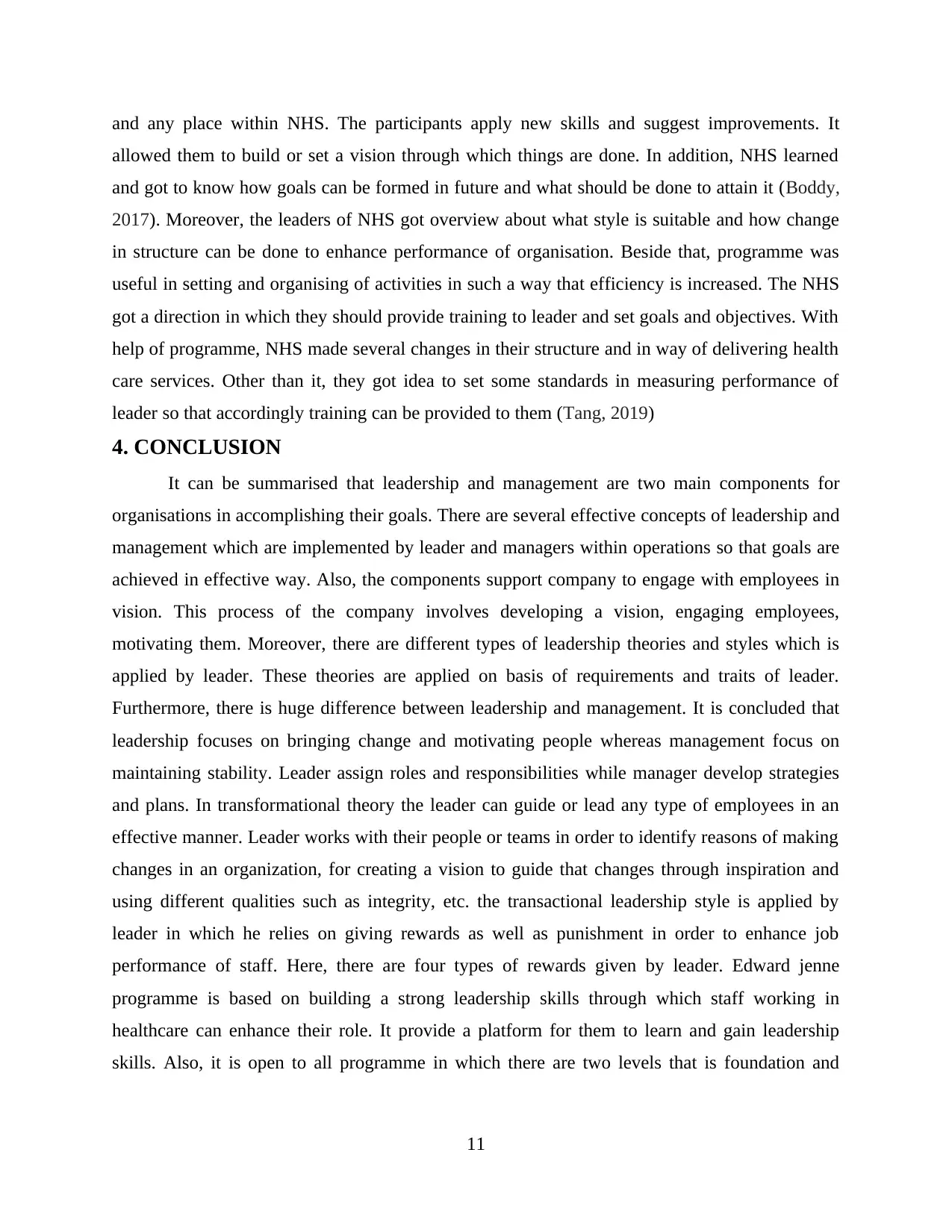
and any place within NHS. The participants apply new skills and suggest improvements. It
allowed them to build or set a vision through which things are done. In addition, NHS learned
and got to know how goals can be formed in future and what should be done to attain it (Boddy,
2017). Moreover, the leaders of NHS got overview about what style is suitable and how change
in structure can be done to enhance performance of organisation. Beside that, programme was
useful in setting and organising of activities in such a way that efficiency is increased. The NHS
got a direction in which they should provide training to leader and set goals and objectives. With
help of programme, NHS made several changes in their structure and in way of delivering health
care services. Other than it, they got idea to set some standards in measuring performance of
leader so that accordingly training can be provided to them (Tang, 2019)
4. CONCLUSION
It can be summarised that leadership and management are two main components for
organisations in accomplishing their goals. There are several effective concepts of leadership and
management which are implemented by leader and managers within operations so that goals are
achieved in effective way. Also, the components support company to engage with employees in
vision. This process of the company involves developing a vision, engaging employees,
motivating them. Moreover, there are different types of leadership theories and styles which is
applied by leader. These theories are applied on basis of requirements and traits of leader.
Furthermore, there is huge difference between leadership and management. It is concluded that
leadership focuses on bringing change and motivating people whereas management focus on
maintaining stability. Leader assign roles and responsibilities while manager develop strategies
and plans. In transformational theory the leader can guide or lead any type of employees in an
effective manner. Leader works with their people or teams in order to identify reasons of making
changes in an organization, for creating a vision to guide that changes through inspiration and
using different qualities such as integrity, etc. the transactional leadership style is applied by
leader in which he relies on giving rewards as well as punishment in order to enhance job
performance of staff. Here, there are four types of rewards given by leader. Edward jenne
programme is based on building a strong leadership skills through which staff working in
healthcare can enhance their role. It provide a platform for them to learn and gain leadership
skills. Also, it is open to all programme in which there are two levels that is foundation and
11
allowed them to build or set a vision through which things are done. In addition, NHS learned
and got to know how goals can be formed in future and what should be done to attain it (Boddy,
2017). Moreover, the leaders of NHS got overview about what style is suitable and how change
in structure can be done to enhance performance of organisation. Beside that, programme was
useful in setting and organising of activities in such a way that efficiency is increased. The NHS
got a direction in which they should provide training to leader and set goals and objectives. With
help of programme, NHS made several changes in their structure and in way of delivering health
care services. Other than it, they got idea to set some standards in measuring performance of
leader so that accordingly training can be provided to them (Tang, 2019)
4. CONCLUSION
It can be summarised that leadership and management are two main components for
organisations in accomplishing their goals. There are several effective concepts of leadership and
management which are implemented by leader and managers within operations so that goals are
achieved in effective way. Also, the components support company to engage with employees in
vision. This process of the company involves developing a vision, engaging employees,
motivating them. Moreover, there are different types of leadership theories and styles which is
applied by leader. These theories are applied on basis of requirements and traits of leader.
Furthermore, there is huge difference between leadership and management. It is concluded that
leadership focuses on bringing change and motivating people whereas management focus on
maintaining stability. Leader assign roles and responsibilities while manager develop strategies
and plans. In transformational theory the leader can guide or lead any type of employees in an
effective manner. Leader works with their people or teams in order to identify reasons of making
changes in an organization, for creating a vision to guide that changes through inspiration and
using different qualities such as integrity, etc. the transactional leadership style is applied by
leader in which he relies on giving rewards as well as punishment in order to enhance job
performance of staff. Here, there are four types of rewards given by leader. Edward jenne
programme is based on building a strong leadership skills through which staff working in
healthcare can enhance their role. It provide a platform for them to learn and gain leadership
skills. Also, it is open to all programme in which there are two levels that is foundation and
11

launch. Individual get benefit from it as those who are newly employed in health care and want
to become a leader. In NHS all health care workers will be able to work together at all levels.
12
to become a leader. In NHS all health care workers will be able to work together at all levels.
12
⊘ This is a preview!⊘
Do you want full access?
Subscribe today to unlock all pages.

Trusted by 1+ million students worldwide
1 out of 14
Related Documents
Your All-in-One AI-Powered Toolkit for Academic Success.
+13062052269
info@desklib.com
Available 24*7 on WhatsApp / Email
![[object Object]](/_next/static/media/star-bottom.7253800d.svg)
Unlock your academic potential
Copyright © 2020–2025 A2Z Services. All Rights Reserved. Developed and managed by ZUCOL.





